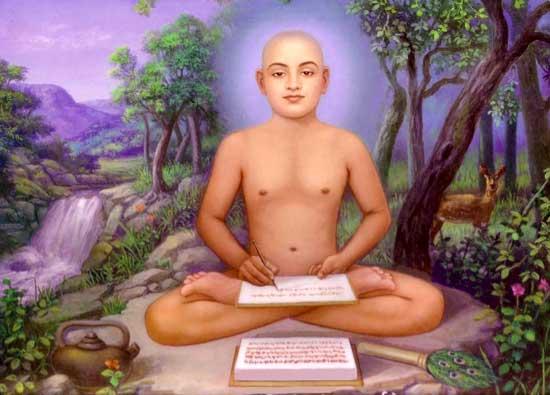A Story of Acharya Kundakunda

मंगलं भगवान वीरो, मंगलं गौतमो गणि।
मंगलं कुन्दकुन्दार्यो, जैन धर्मोस्तु मंगलम्॥
maṅgalaṃ bhagavāna vīro, maṅgalaṃ gautamo gaṇi |
maṅgalaṃ kundakundāryo, jaina dharmostu maṅgalam ||
Bhagawan Mahavir is auspicious; Ganadhar Gautam Swami is auspicious;
Acharya Kundakunda is auspicious; Jain religion is auspicious.
The great spiritual saint Acharya Kundakunda occupies the highest place in the tradition of Jain Acharyas. He is remembered immediately after Bhagawan Mahavir and the preceptor Gautam Ganadhar as an auspicious blessing. Every day, Digambar Jains recite the couplet with the three adorable reverentially before starting the study of religious texts. Jain monks feel honored in being included in the tradition of Acharya Kundakunda.
In the southern state of Tamilnadu in India, atop a hill known as Ponnur Malai, on a large stone under a certain Champa tree, pilgrims may stumble upon an engraved pair of footprints (Charan). These footprints are symbolic of a thinker who, nearly two thousand years ago, composed some of the most influential philosophical books. Generations of scholars can remember the exact day of their first encounter with this thinker’s spiritual masterpiece, the Samay-sar.
Acharya Kundakunda is one of the most famous Jain Acharyas. He is a great organizer of the highly complex concepts of Jain philosophy. He is the celebrated author of five renowned books:
- Samay-sar (Treatise on the True Self)
- Pravachan-sar (Treatise of Preaching)
- Niyama-sar (Treatise on Rules of Conduct)
- Panchastikaya (Treatise on Five Universal Substances)
- Ashta-pahud (Eight Steps), a collection of eight texts
All his works are written in an ancient dialect known as Saurseni Prakrit which is similar to Ardha-magadhi Prakrit. The organizing of Jain ideas into certain relationships and structures, taken for granted in recent centuries, was a product of his genius. So extraordinary was this idea that many other books written in this style by his pupils and other Jain scholars are popularly ascribed to him. In the Digambar tradition, he is praised immediately after Lord Mahavir and the preceptor Gautam-swami in the auspicious blessing (Mangalacharan) prayer.
Jains of the Digambar tradition dub their tradition Kundakunda Anvaya (the order of Kundakunda). However, scholars of all sects study his books with deep veneration. He was born around the beginning of the first century AD in Southern India in a place named Konda konda. Kundakunda belonged to an ancient order called the Nandi Sangha, wherein most monks assumed names ending in “Nandi”. His official name after becoming a Jain monk was Padma-nandi, but he is better known by the place of his origin. Kundakunda mentions that he was a descendant of Bhadrabahu swami, the last Shruta Kevali Acharya who possessed complete knowledge of the twelve Anga Agams including the 14 Purvas.
Punya Shravak Katha Kosha mentions that in his previous life Kundakunda was a cow herder who had found and preserved ancient texts and was blessed by a wandering monk. Acharya Kundakunda’s intense learning and moral character attracted royal disciples such as King Shiva Kumar. The story of Kundakunda is also surrounded by a legend - it is even said that he could walk on air.
Kundakunda’s influence extends far beyond Jainism. India has always been a land where philosophical debates are a standard feature of intellectual life. The concise and systematized aphorisms he brought to Jain literature were unparallel. Kundakunda’s creativity allowed him to utilize existing literary structures to explain Jainism’s most advanced scientific principles such as atomic structure, cosmic dimensions, the cosmic ethers, and psychology. His treatises rivaled any other writing to date. Hindu and Buddhist thinkers were challenged to respond to his explications of Jain philosophy and conduct. Kundakunda elevated the level of scholarship and debate in India’s overall philosophical discourse.
Out of enthusiastic respect, Acharya Kundakunda has been called “Light of this Dark Age”. Several commentaries on his Samay-sar have been written in Sanskrit and in modern languages. In recent centuries, the Samay-sar has greatly moved leaders and scholars like Banarasi Das, Tarana Swami, Shrimad Rajchandra and Gurudev Shri Kanji Swami.